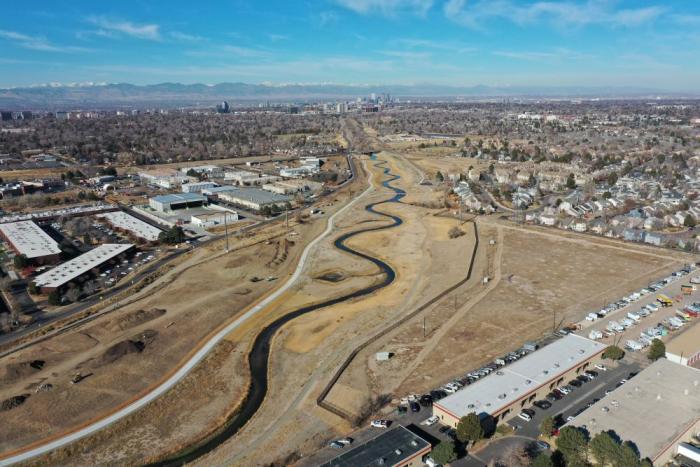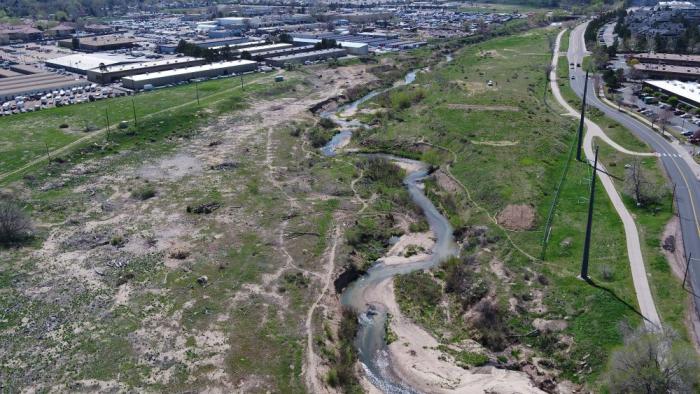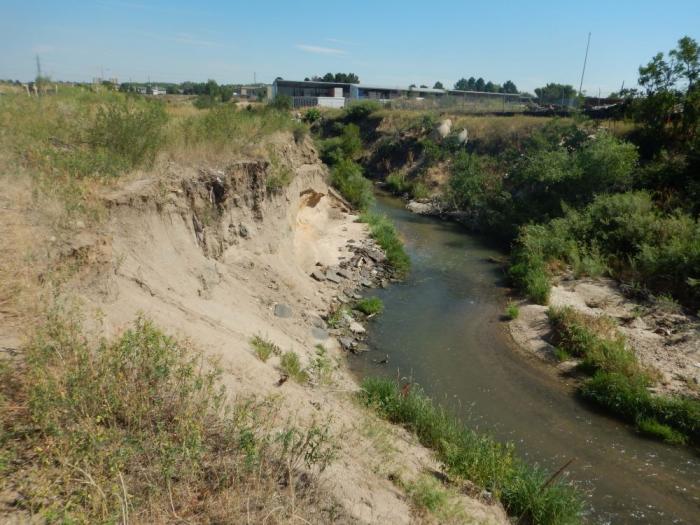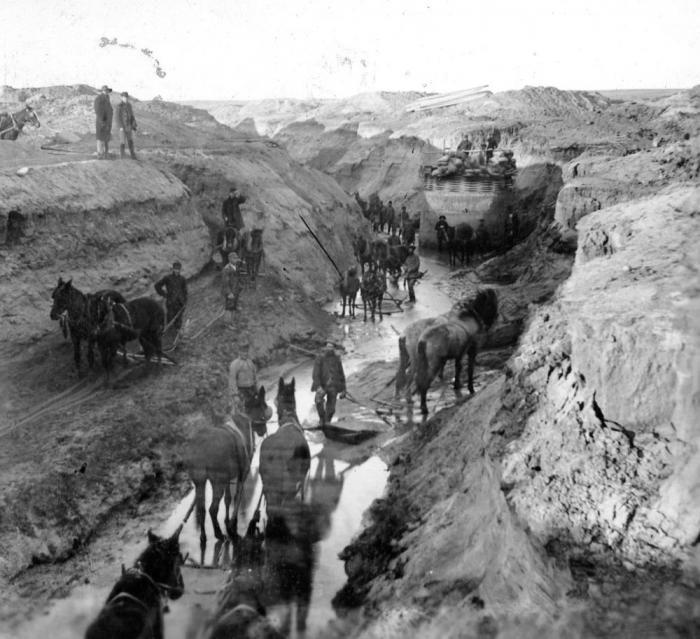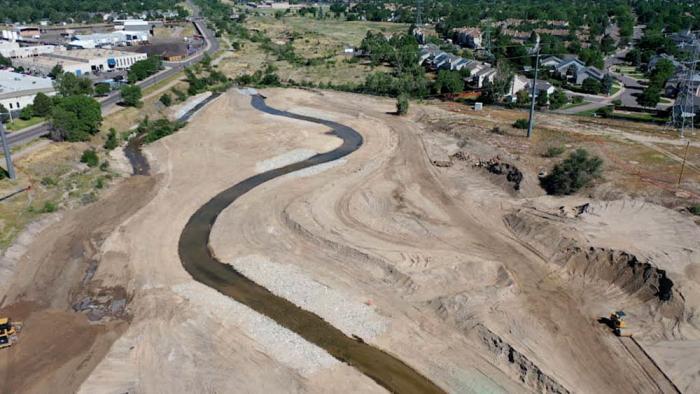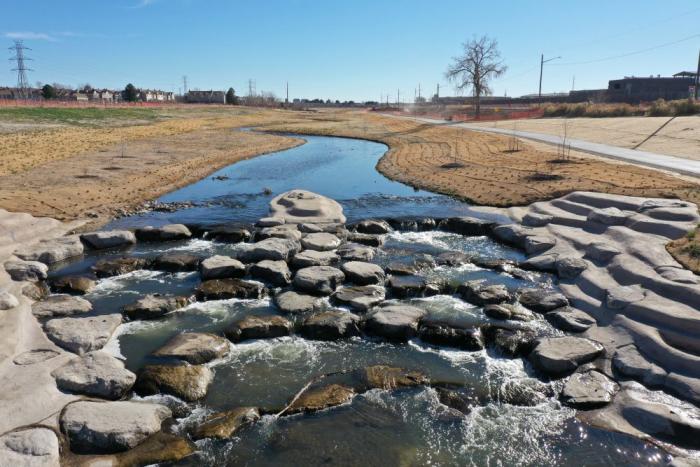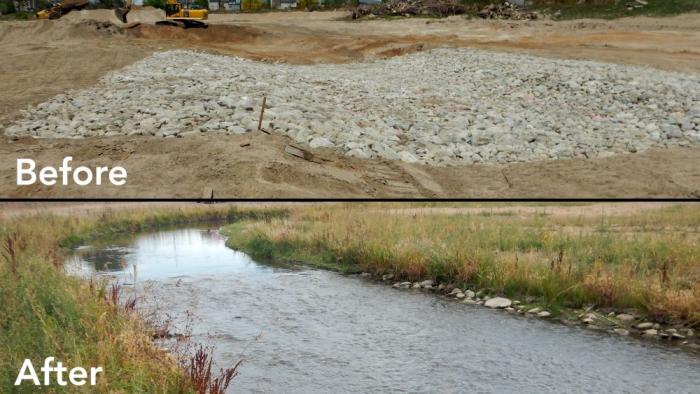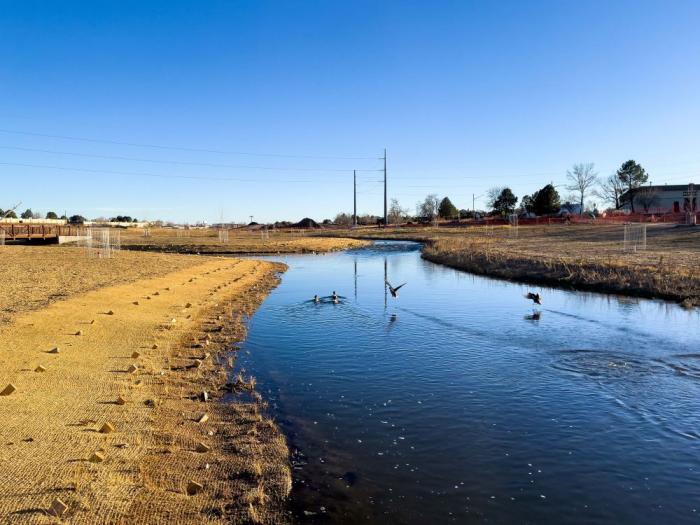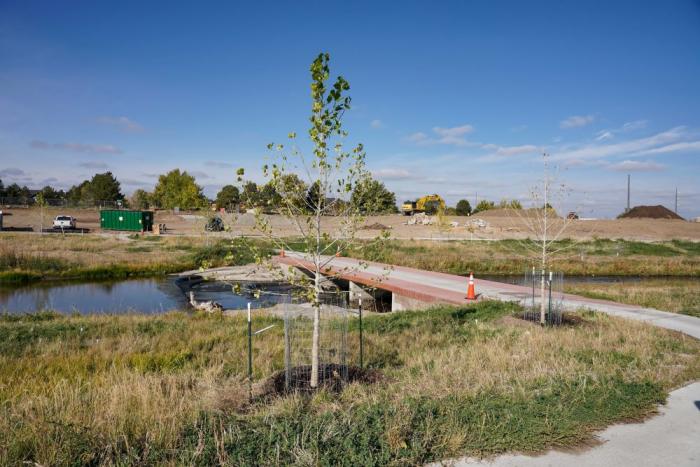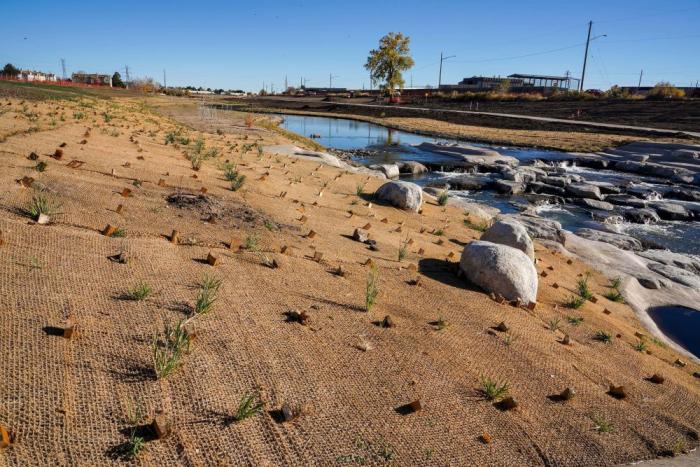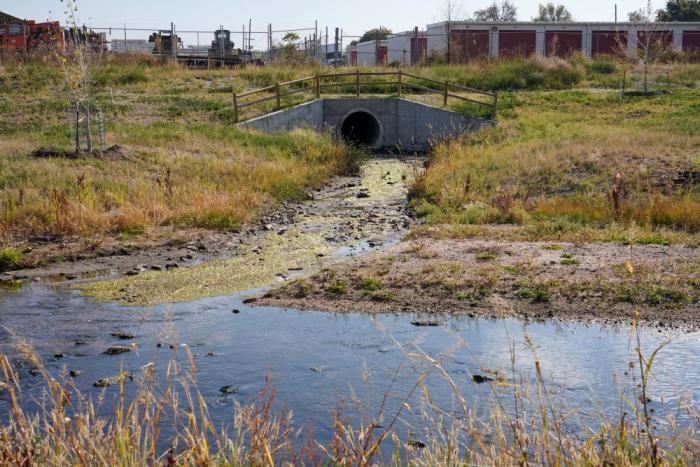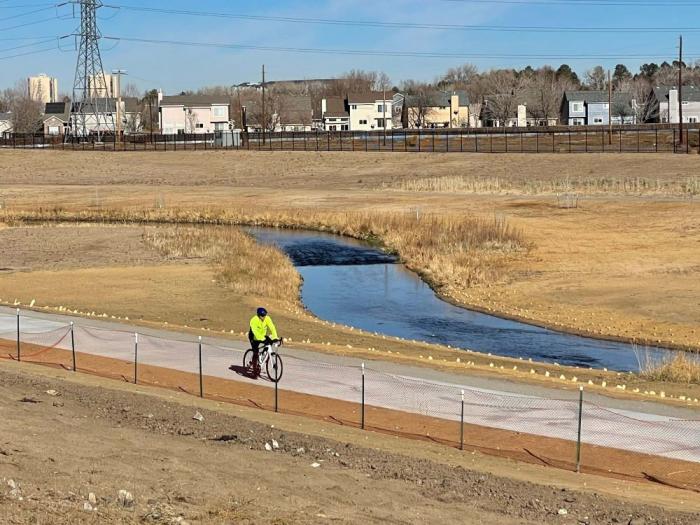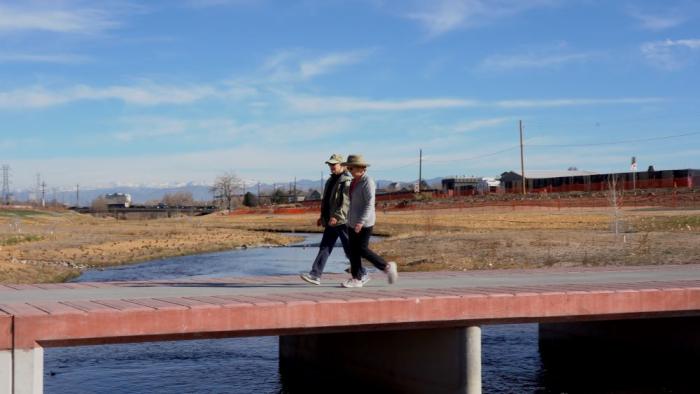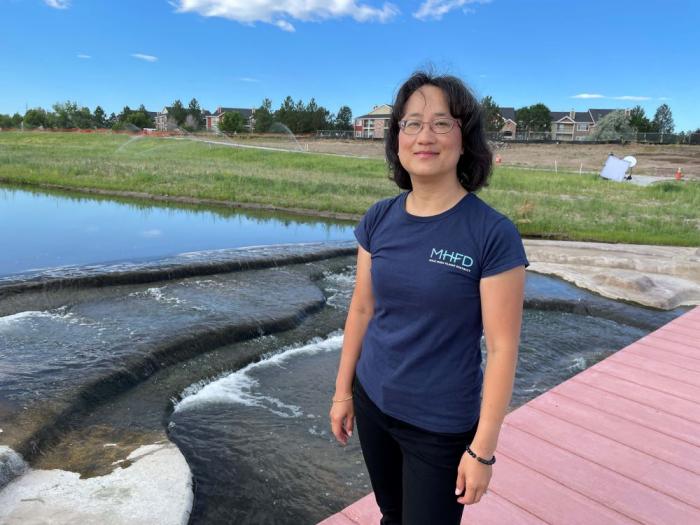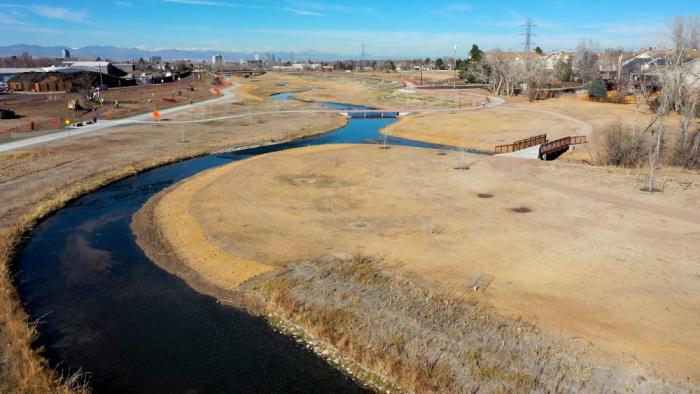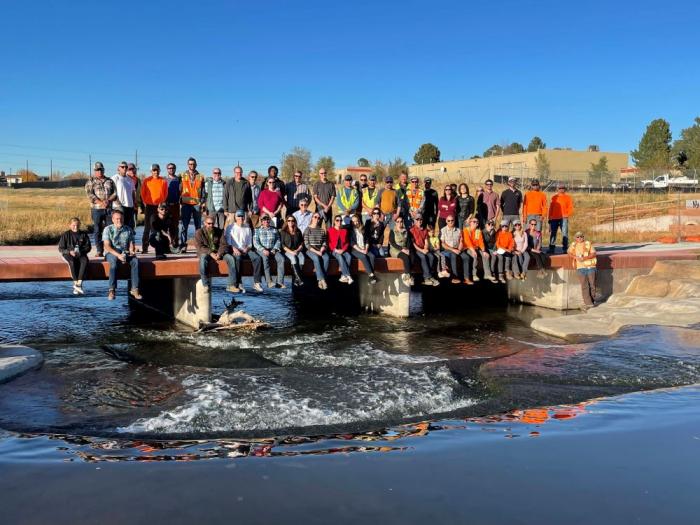Creating a new ‘urban oasis’ along Cherry Creek
A stretch of Cherry Creek straddling the border between Denver and Arapahoe County has a new look.
The mile-long section opened to the public Nov. 24 after an eight-year effort to restore the area that had seen a large amount of erosion. The finished work will improve stormwater runoff management, water quality, wildlife habitat and recreation between East Iliff Avenue and South Quebec Street.
The restored section features a wider flood corridor, a stabilized meandering streambed and native plants, along with new and improved recreation paths.
The Mile High Flood District led the Cherry Creek Restoration Project, along with Denver Water, the City and County of Denver, Arapahoe County, Southeast Metro Stormwater Authority and the Colorado Water Conservation Board.
The Flood District was created in 1969 and serves seven counties in metro Denver. The organization identifies problem waterways in the metro area and finds solutions to protect people, property and the environment.
“The vision for the Cherry Creek project was to create a healthy stretch of water that also was connected to its community,” said Barbara Chongtoua, engineering services manager for the Mile High Flood District.
Read more about Denver Water’s infrastructure projects.
Cherry Creek is one of the most prominent waterways in the Denver metro area. But as development grew around the creek, the flow of water into the streambed changed.
“As people moved into the area, more roofs and roads encroached on the creek. So, during big rainstorms, instead of water going into the creek slowly and soaking into the nearby ground, more water flowed faster into a narrower streambed, which caused severe erosion,” Chongtoua said.
The erosion created a miniature canyon through the corridor, which caused several problems, including:
- Creek banks that caved into the stream and created water quality problems.
- Trees and plants that were unable to survive in a degraded streambed.
- Erosion that threatened residential and commercial properties.
- Dangerous conditions for people who walked along the creek bank.
- Safety concerns that some portions of the recreational path might collapse.
- Exposure of underground utility pipes.
Denver Water played a key role in making the restoration project happen because the utility owned the land around the creek.
“We’ve owned the land for over 100 years and still have active wells and pipes on the property,” said Katie Ross, Denver Water’s project manager for the restoration effort. “But over the last 30 to 40 years, we realized we didn’t need to own as much property, so we donated about 25 acres to Denver and Arapahoe County.”
Denver Water’s donation set into motion a collaborative effort to turn the degraded stretch of land into a valuable open space corridor.
“We all got together to find ways to improve this area from a drainage, environmental and recreational standpoint to benefit people and wildlife,” said Shannon Carter, director of Arapahoe County Open Spaces Department.
The project partners enlisted the help of Muller Engineering Co., Stream Landscape Architecture + Planning, Great Ecology, Pinyon Environmental, Corvus Environmental, Hydrosystems-KDI, Ecological Resource Consultants, CTL Thompson and Topographic Land Surveyors to restore the stretch of creek so that it would look and function like it did before roads, homes and businesses were built nearby.
Concrete Express Inc. and Western States Reclamation Inc. began construction in fall 2019. The work involved widening the flood corridor and regrading a shallow, active channel with gentle meandering curves so that the water will flow slowly downstream during small and large rainstorms.
“We added 20 grade control structures to stabilize the active channel bed and slow down the flow of water, ultimately reducing erosion,” said Joe Juergensen, the project principal with Muller Engineering.
“The project will improve water quality by reducing the amount of sediment that falls into the water and allowing pollutants time to settle to the bottom,” said Jessica Andersen, senior resiliency planner with Denver Parks and Recreation.
The project also included adding native grasses, willows and 350 new trees to help restore the project site and stabilize the stream corridor. This new vegetation also will provide the additional benefit of shade for people and new habitat for wildlife.
Learn more about the improvements in this video with Joe Juergensen, design project engineer with Muller Engineering.
“This project was about rebuilding the ecosystem from the ground up and adding native plants that will thrive here and that wildlife will enjoy,” Andersen said.
It will take several years for the grasses, plants and trees to become well established. Supplemental watering and maintenance will be provided until the plants are self-sufficient.
The project also included improvements to the Cherry Creek Regional Trail, which is one of the most popular biking and walking routes in the metro area.
“One of the biggest benefits of the project is a new, wider trail with a soft-surface gravel trail next to it to give people more space. There’s also a new secondary trail, which provides access to the east side,” Carter said. “The trails will be away from the street so it will be much safer too.”
Significant improvements have been made to bring people closer to nature along the trail — whether they are biking, walking or just looking for a place to relax. There will be several seating areas and three new pedestrian bridges to let people go across the creek to a side that was previously private property.
Chongtoua said the project cost around $16 million and could not have been built without the help of all the public partners and private contractors.
“We are very happy with the results of the project,” Chongtoua said. “We’ve created a safer and more equitable space for people to come out and enjoy nature.”
One of the project partners, Arapahoe County, has been working to improve the trail system along Cherry Creek for years and was happy to lend its support.
“These are the types of projects our citizens support,” Carter said. “We were able to use money from Arapahoe County’s 2003 sales and use tax to help fund this project, so we’re excited to bring it to our community.”
The Colorado Water Conservation Board provided significant financial support, awarding the project a $500,000 grant to help pay for improvements.
“We love these types of collaborative projects because we can leverage our financial resources with our partners to create a bigger and better benefit for the community,” Andersen said.
The project also earned national attention and was selected as a 2020 Environmental Business Journal Project Merit Award winner for “successfully avoiding, minimizing and mitigating environmental conflicts during the design and construction process.”
“Denver Water is one of the largest landowners in the state, and it’s exciting when we can find opportunities to improve the environment and enhance recreation while meeting our operational needs,” Ross said. “As a project partner we’re really looking forward to seeing the public enjoy this new space.”


